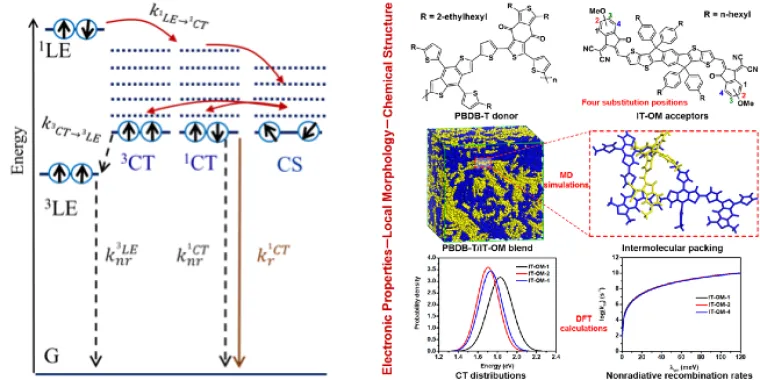Organic solar cells (OSCs) are currently attracting significant interest due to a number of appealing characteristics such as low cost, low environmental impact, solution-processing ability, conformability, and large-area manufacturing capability. Recent advances in the design of new electron-donor and electron-acceptor materials, optimization of the active-layer morphology, device engineering, modeling, and other disciplines resulted in the development of OSC devices with power conversion efficiencies over 18% in single-junction cells.
By exploiting an integrated approach that combines quantum-chemical calculations based on density functional theory, theoretical modeling, molecular dynamics simulations at atomistic and coarse-grained levels, and kinetic Monte Carlo simulations, our studies focus on establishing chemical structure–morphology–electronic properties–performance relationships. We are currently interested in OSCs where the active layers are based on binary or ternary blends of polymer donors with small-molecule nonfullerene acceptors. We address a number of fundamental issues related to the description of the photo-excited states, and the processes of charge separation and charge recombination at the donor/acceptor interfaces as well as of energy and charge transport in the active layer.
While the electronic properties clearly play a key role in determining device performance, the morphological properties of active layers are also important factors. Work in our group addresses the following questions: (i) How do the polymer chains or molecules pack in the pure and mixed phases when two or more materials form a blend? (ii) How do the intramolecular conformations and intermolecular configurations impact the electronic properties? (iii) How can we provide a multi-scale description of these blends from local to global morphology? (iv)How do we relate the global morphology and electronic properties to device performance?

Recent publications:
-
G. Zhang, X.K. Chen, J. Xia, P. C. Y. Chow, M. Ren, G. Kupgan, X. Jiao, C. C. S. Chan, X. Du, R. Xia, Z. Chen, J. Yuan, Y. Zhang, S. Zhang, Y. Liu, Y. Zou, H. Yan, K.S. Wong, V. Coropceanu, N. Li, C. J. Brabec, J.L. Brédas, H.L. Yip, and Y. Cao, “Delocalization of Exciton and Electron Wavefunction in Non-fullerene Acceptor Molecules Enables Efficient Organic Solar Cells”, Nature Communications, 11, 3943 (2020).
-
T. Wang, G. Kupgan, and J.L. Brédas, “Organic Photovoltaics: Relating Chemical Structure, Local Morphology, and Electronic Properties”, Trends in Chemistry, 2, 535-554 (2020).
-
H. Li, G. Sini, J. Sit, A. J. Moulé, and J.L. Brédas, “Understanding Charge Transport in Donor/Acceptor Blends from Large-Scale Device Simulations Based on Experimental Film Morphologies”, Energy & Environmental Science, 13, 601-615 (2020).
-
T. Wang and J.L. Brédas, “Organic Solar Cells Based on Non-fullerene Small-Molecule Acceptors: Impact of Substituent Position”, Matter, 2, 119-135 (2020).
-
V. Coropceanu, X.K. Chen, T. Wang, Z. Zheng, and J.L. Brédas, “Charge-Transfer Electronic States in Organic Solar Cells”, Nature Reviews Materials, 4, 689-707 (2019).
-
X.K. Chen, V. Coropceanu, and J.L. Brédas, “Assessing the Nature of the Charge-Transfer Electronic States in Organic Solar Cells”, Nature Communications, 9, 5295 (2018).
-
D. Qian, Z. Zheng, H. Yao, W. Tress, T.R. Hopper, S. Chen, S. Li, J. Liu, S. Chen, J. Zhang, X.K. Liu, B. Gao, L. Ouyang, Y. Jin, G. Pozina, I. Buyanova, W. Chen, O. Inganäs, V. Coropceanu, J.L. Brédas, H. Yan, J. Hou, F. Zhang, A.A. Bakulin, and F. Gao, “Design Rules for Minimizing Voltage Losses in High-Efficiency Organic Solar Cells”, Nature Materials, 17, 703-709 (2018).
-
H. Ade, L. Ye, H. Hu, M. Ghasemi, T. Wang, B. Collins, J.H. Kim, K. Jiang, J. Carpenter, H. Li, Z. Li, T. Mcafee, J. Zhao, X. Chen, J.Y.L. Lai, T. Ma, J.L. Brédas, and H. Yan, “Quantitative Interaction-Miscibility-Function Relations in Organic Solar Cells”, Nature Materials, 17, 253-260 (2018).

